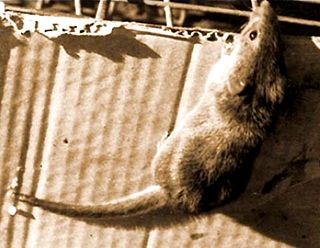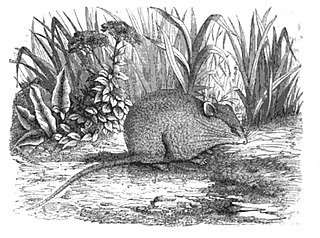
Pseudomys is a genus of rodent that contains a wide variety of mice native to Australia and New Guinea. They are among the few terrestrial placental mammals that colonised Australia without human intervention.
Notiomys edwardsii, also known as Edwards's long-clawed mouse, Edward's long-clawed akodont, or Milne-Edwards' long-clawed mouse, is a rodent in the tribe Abrotrichini from southern Argentina. It is the only species in the genus Notiomys, although species of Chelemys and Geoxus were formerly included in that genus.

The candango mouse or candango akodont is an extinct rodent species from South America. It was found around Brasília until the 1960s when its habitat was overtaken by urban sprawl and it is now presumed extinct.
The Kashmir field mouse is a species of rodent in the family Muridae. It is found in India, Nepal, and Pakistan.

Geoxus valdivianus, also known as the long-clawed mole mouse or Valdivian long-clawed akodont, is a species of rodent in the tribe Abrotrichini of family Cricetidae found in the Valdivian temperate rain forests and Magellanic subpolar forests of Argentina and Chile. It is one of two species in the genus Geoxus.
The Awash multimammate mouse or Awash mastomys is a species of rodent in the family Muridae found only in Ethiopia. Phylogentically the Awash multimammate mouse is the sister taxon of the Natal multimammate mouse, a species found almost everywhere in Africa south of the Sahara and considered a serious agricultural pest throughout its range.
The rock-loving mouse, also known as the brown spiny mouse, is a species of rodent in the family Muridae. It is found in India, Nepal, and Pakistan.
The earth-colored mouse is a species of rodent in the family Muridae. It is found in India, possibly Indonesia, Nepal, and Pakistan. The earth-colored mouse lives in cultivated fields in raised moist mounds of Earth, where they burrow and locate their nest about 20 cm or 8 inches deep. Living in a raised mound of soil offers them more oxygen flow from air coming through the surrounding sides as well as from above. In contrast, their co-existing sibling species Mus booduga burrow in the flat parts of the field, which allows for niche differentiation.
The false canyon mouse or Coronados deer mouse, is a species of rodent in the family Cricetidae. It is known only from Coronados Island, a small island in the Gulf of California, part of Baja California Sur, Mexico. The species is threatened by predation by feral cats, and the IUCN has assessed its conservation status as "critically endangered".
The gray-bellied tree mouse is a species of rodent in the family Muridae. It is found only in Papua New Guinea.

The ash-grey mouse is a rodent in the family Muridae. Larger and more robust than Mus musculus, the common house mouse, it is found only in Southwest Australia.

Bolam's mouse is a species of nocturnal, burrowing rodent in the family Muridae that inhabits the semi arid and southern arid regions of Australia. It has a number of physiological and behavioural adaptations developed to cope with an extremely varied climate. Including the ability survive by extracting water from seeds alone, the production of highly concentrated urine, low water content faeces and nocturnal activity.

The little native mouse, also known as the delicate mouse, is a species of rodent in the family Muridae. The Kunwinjku people of western Arnhem Land call this little creature kijbuk.
The country mouse also known as the pebble-mound mouse or eastern pebble mound mouse is a species of rodent in the family Muridae. It lives only in Australia, where it is considered rare. It was described by Thomas and Dollman in 1909.
The tiny fat mouse is a species of rodent in the family Nesomyidae. It is found in Angola, Botswana, Ethiopia, Kenya, Mozambique, Namibia, South Sudan, Tanzania, Uganda, Zambia, and Zimbabwe. Its natural habitats are subtropical or tropical dry shrubland and subtropical or tropical dry lowland grassland.

The northern grasshopper mouse is a North American carnivorous rodent of the family Cricetidae. It ranges over much of the western part of the continent, from southern Saskatchewan and central Washington to Tamaulipas in northeast Mexico.
The Rio Guaporé mouse or Guaporé akodont was formerly considered a rodent species in the family Cricetidae. It is known only from a small savanna in eastern Bolivia near the Rio Guaporé. However, in 2012 it was described as being conspecific with J. huanchacae.
The Huanchaca mouse or Huanchaca akodont is a rodent species in the family Cricetidae. It is known from savannas in an area at an elevation of 700 metres (2,300 ft) in Serrania Huanchaca, Noel Kempff Mercado National Park in eastern Bolivia.
Rhagomys is a genus of South American rodents in the tribe Thomasomyini of the family Cricetidae. Two species separated by about 3100 km are known, from southeast Peru and Bolivia east of the Andes, and in the Atlantic Forest of southeast Brazil. An undetermined species of Rhagomys has also been reported from Mato Grosso in central Brazil. The species are as follows:
João Moojen de Oliveira was a zoologist dedicated to the systematics of Brazilian mammals, particularly rodents and primates. He was also interested in birds. He collected extensively between the 1930s and 50s and wrote "Os Roedores do Brasil" in 1952, a key book on Brazilian rodents. He was an authority on spiny rats of the genus Phyllomys. As well as performing research, Moojen worked significantly as a teacher and technical advisor; positions held include: head of the Biology Department of Escola Superior de Agricultura e Veterinária do Estado de Minas Gerais, in Viçosa; Professor-Head of Natural History of Colégio Universitário da Universidade do Brasil; Naturalist of Vertebrate and Invertebrate Zoology Division of Museu Nacional including headed this division into two stages and collected most of the mammals deposited in this collection and in Universidade do Estado do Rio de Janeiro; zoologist of the Rockefeller Foundation; member of Society of the Sigma Xi for the Promotion of Research in Science, the American Society of Mammalogists, the Cooper Ornithological Club and Phi Sigma Biological Society; commissioned by the Federal Government to organize the Brasília Zoo-Botanical, and was also Director of the Department for Nature Protection of Brasília.







